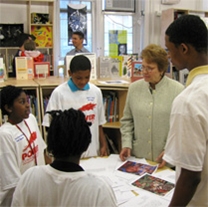 |
Recipient: Grant: Pictured: |
Contact: |
||
For decades, irreplaceable PTA scrapbooks, historical school photos, and roll books dating from 1926 to 1967 languished in a little-used room of Capitol Hill’s Stuart-Hobson Middle School. Rediscovered during the 2006 renovation of the school library, the archival treasures shed light on the ethnic and national origins of the families, parents’ occupations, and outbreaks of serious diseases such as scarlet fever. In 2007, school librarian Janice McKinnon applied for and received a grant from the District of Columbia Public Library (DCPL) to rescue the documents and develop a school archives. The DCPL grant was funded by the Institute of Museum and Library Services (IMLS).
The grant enabled the school to hire two part-time archivists, Satu Haase-Webb and Elizabeth Behrendt. Under their direction, students sorted, catalogued, and preserved the artifacts. They are still adding to the archives by clipping and archiving news articles about their school and the Capitol Hill Cluster School consortium. Maya Rimpsey, a 5th grader who relied on the archives for a National History Day project, said she has been inspired to become an archivist when she grows up.
"This school has a unique history. The documents tell the story of what happened in this country when the schools were integrated," said Lucy Labson, DCPL grants manager. The Stuart Junior High School was built on Capitol Hill in the 1920s for white students only. In 1954, District public schools were integrated in response to the Bolling v. Sharpe decision handed down at the same time as the Brown v. Board of Education decision.
The project’s second goal was to build a storage space for the rescued artifacts. Project leaders enlisted the pro bono services of the Catholic University of America Design Collaborative. The collaborative designed both the Stuart Hobson library and archive space, with its undulating plexiglass screen imprinted with images of former students, an archival work space with scanner and computer, and wooden storage bins that house copies of the documents.
The students have taken the project beyond the original grant proposal by learning how to conduct oral histories of famous graduates who have gone on to exceptional careers in business, politics, sports, writing, and other fields. Courtney Thomas Jr., a seventh grader, learned from former students and PTA board members about the school’s integration. He said that interviewing former students was "a better way for me to get educated about Washington’s and the school’s history."
"The outreach efforts for gathering additional archival materials and oral histories have involved everyone who lives in the neighborhood," McKinnon wrote in the project’s final report. "That effort, and publicity about the archives, has brought a number of people into the school to donate items from their homes and families and to see what is already catalogued. All of our students are hearing about the ‘detective’ work being done about their school, and that has generated high interest and pride, as well as a desire to participate."
In honor of the newly-created school archives, students buried a time capsule containing essays on the eighth grade students’ hopes and dreams as a "letter to the future" in honor of the "letters from the past" they have received in the form of the archives. One student wrote, "I hope for our economy to get better. We’re in a recession right now so my parents are having trouble about me going to high school."
Anne-Imelda Radice, IMLS Director, toured the newly created archives and commended the students on their contributions to the school and its archives.
"I’m so glad that the Stuart-Hobson students are learning about conservation and how to take care of collections so that all these great stories from the past – and their own stories – will be preserved," Radice said. "These archives help us learn about our place in history and that’s why it’s important to preserve these documents, photos, and other items for the future."